The Leibniz-IZW regular publishes press releases on key findings and insights from its research and on events, awards or personalia. The press releases are distributed directly to journalists on our press release distribution mailing list. Press releases are also disseminated through the distribution services Informationsdienst Wissenschaft, AlphaGalileo and EurekAlert. Are you interested in receiving our press releases directly via e-mail? In this case please send us an email to presse@izw-berlin.de.
Current press releases

The ethics of biobanking for conservation: BioRescue adjusts ethical assessment tool for the use of genome research banks
In the face of the global biodiversity crisis, more and more biobanks are being set up to safeguard and potentially restore genetic diversity. Preserved tissue or cells allow scientists and conservationists to overcome spatial and even temporal fragmentations of dwindling wildlife populations and employ assisted reproduction technologies – as long as biobanks can be used in a safe and ethically appropriate manner. In a new scientific paper in the journal “Cryobiology”, the BioRescue team systematically evaluates these ethical considerations related to, among others, animal welfare, sample ownership and good scientific practice. The team also presents a modification of its “ETHAS” tool as a clear, easy-to-adopt and standardised technique for a structured and organised ethical assessment and decision making in the context of biobanking.
_web-3kacbdx5beryzfv.jpg)
Systematic monitoring: Leibniz-IZW carries out 1000th wolf autopsy since the species’ comeback to Germany
At the turn of the millennium, grey wolves returned to Germany after 150 years and subsequently established territories in many parts of the country. But coexistence harbours challenges – for both humans and animals. Since 2006, almost all grey wolves found dead in Germany have been examined at the Leibniz Institute for Zoo and Wildlife Research (Leibniz-IZW) in order to assess their health status and determine the cause(s) of death. Recently, the 1000th wolf lay on the dissecting table at the Leibniz-IZW. The female animal died as a result of a road accident – by far the most common unnatural cause of death for grey wolves in Germany. The case speaks volumes about the successful but challenging return of grey wolves.
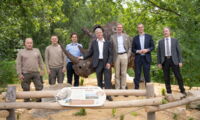
Tierpark Berlin establishes research station for international species conservation program BioRescue
Press release of the Tierpark Berlin - The Northern White Rhinoceros is on the brink of extinction; only two females remain, living in a nature reserve in Kenya. Without collaborative action, this rhinoceros species, once native to Central Africa, will disappear from the Earth forever. Although the extinction of this subspecies of the White Rhinoceros seems inevitable, researchers from the international BioRescue team, led by the Leibniz Institute for Zoo and Wildlife Research (Leibniz-IZW), Germany, and coordinated by ZOO Dvůr Králové, Czech Republic, are working on developing and utilizing new methods of vital reproduction for wildlife to save these ecologically valuable giants from complete extinction. Tierpark Berlin will now cooperate with these scientists to implement a crucial step in the project, which will hopefully result in one of the first calves of this endangered species.
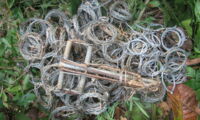
Wire snare removal in protected areas is labour-intensive but effective – and essential to solving the Southeast Asian snaring crisis
Snaring – a non-selective method of poaching using wire traps – is widespread in tropical forests in Southeast Asia. Snaring decimates wildlife populations and has pushed many larger mammals to local or even global extinction. Eleven years of data from ranger patrols in the Thua Thien Hue and Quang Nam Saola Nature Reserves in Viet Nam show that intensive removal efforts are labour-intensive and costly but brought snaring down by almost 40 percent and therefore reduced imminent threats to wildlife. Further reductions were difficult to achieve despite continued removal efforts. Snare removal is therefore necessary but by itself not sufficient to save the threatened wildlife diversity in tropical forests, scientists conclude in the journal “Conservation Letters”.
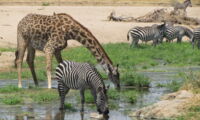
Out on dry land: Water shortage threatens species in Ruaha National Park in Tanzania
Climate change is not the only cause of arid landscapes: a research team led by the Leibniz Institute for Zoo and Wildlife Research (Leibniz-IZW) has investigated the consequences of increased water abstraction for agriculture and livestock farming from the Great Ruaha River. This river, which used to flow continuously, now dries up for months at a time. The scientists showed that some herbivores were able to partially compensate for the temporary lack of water through their diet, whereas others have little or no ability to do so. In particular, African buffalo, plains zebra and waterbuck were sometimes severely restricted in their habitat use as a result. The effects of water scarcity on Ruaha National Park’s biodiversity are described in an article in the scientific journal “Wildlife Biology”.
Read more … Out on dry land: Water shortage threatens species in Ruaha National Park in Tanzania

Wind energy and bat conservation: scientists call for the global application of measures to reduce fatalities
The construction of wind turbines as a cornerstone for the production of climate-friendly electricity is rapidly increasing all over the world – and everywhere this results in major challenges for bats, which die directly at the turbines or lose valuable habitats in their vicinity. A research team from Australia, Brazil, France, Germany, Kenya, Puerto Rico, Taiwan, the United Kingdom and the USA now analysed possible solutions to this green-green conflict on a global scale and identified the steps required to improve the balance between climate protection and biodiversity conservation. For example, scientifically proven methods for reducing bat casualties need to be implemented more consistently into regulations for the operation of wind turbines worldwide and significant research gaps on the interaction of bats with turbines in countries of the Global South and in tropical ecosystems need to be closed, the team writes in the scientific journal “BioScience”.
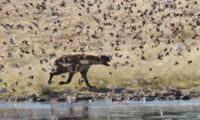
Small birds spice up the already diverse diet of spotted hyenas in Namibia
Hyenas are generalist predators (and scavengers) with a broad range of prey species. They are known for hunting (or scavenging) larger mammals such as antelopes and occasionally feed on smaller mammals and reptiles. Being flexible in the choice of prey is a strategy of generalists – and this even extends to small passerine birds, as scientists from the Leibniz Institute for Zoo and Wildlife Research (Leibniz-IZW) and the University of Ljubljana observed in Namibia: Spotted hyenas pursued red-billed queleas, picked them from the ground or the surface of a waterhole and swallowed them whole, at a success rate of approximately one bird every three minutes. These observations were described for the first time in word, photos and videos in the scientific journal “Food Webs”.
Read more … Small birds spice up the already diverse diet of spotted hyenas in Namibia
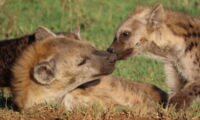
When inequality is more than “skin-deep”: Social status leaves traces in the epigenome of spotted hyenas in Tanzania
A research consortium led by scientists from the Leibniz Institute for Zoo and Wildlife Research (Leibniz-IZW) provide evidence that social behaviour and social status are reflected at the molecular level of gene activation (epigenome) in juvenile and adult free-ranging spotted hyenas. They analysed non-invasively collected gut epithelium samples from both high-ranking and low-ranking female hyenas and showed that rank differences were associated with epigenetic signatures of social inequality, i.e., the pattern of activation or switching off of genes that regulate important physiological processes such as energy conversion and immune response in several genome regions. The results, published in the scientific journal “Communications Biology”, contribute to a better understanding of the role of epigenetic mechanisms in the interplay of social, environmental and physiological factors in the life of a highly social mammal.

